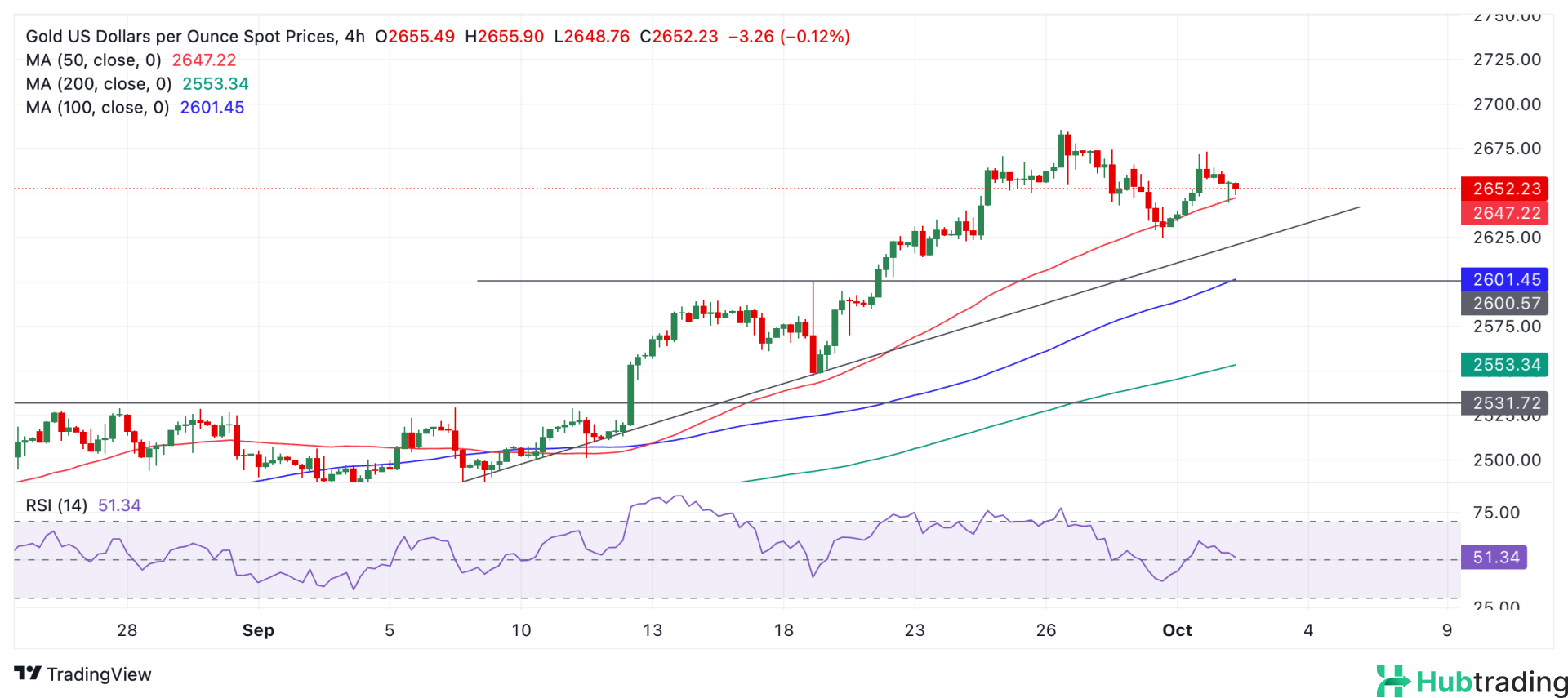- Gold experiences a pullback following Tuesday's rally, driven by heightened geopolitical risks from Iran's actions in the Middle East.
- Despite this, the macroeconomic environment remains favorable, with declining global interest rates boosting gold's appeal.
- From a technical standpoint, XAU/USD is consolidating, presenting a “buy-the-dip” opportunity for bullish traders.
Gold (XAU/USD) dipped on Wednesday, trading in the $2,650 range per troy ounce as traders take a breather following Tuesday's more than 1.0% rally. The surge on Tuesday was primarily driven by instability in the Middle East after Iran launched around 200 missiles, including ballistic ones, targeting Israel's capital, Tel Aviv.
This geopolitical tension, coupled with declining global interest rates, continues to support the precious metal, which remains just below its all-time high of $2,685. Lower interest rates enhance the appeal of non-interest-bearing gold as a portfolio asset for investors.
Volatility from Shifting US Rate Outlook
Gold has experienced fluctuations over the past week due to a rapidly changing outlook for US interest rates, which has also influenced the strength of the US Dollar (USD), further impacting valuations.
Last week, gold prices surged as expectations mounted that the Federal Reserve (Fed) would implement a significant 50 basis point (0.50%) rate cut at its November meeting. This outlook contributed to a weakened USD, bolstering gold's ascent.
However, unexpectedly strong data—particularly regarding the fragile US job market—along with a cautious speech from Fed Chairman Jerome Powell on Monday, have diminished the likelihood of a substantial 50 bps cut, reducing expectations from over 60% last week to just 37% by Wednesday.
Analysts Predict Continued Gold Growth
Despite gold's remarkable 28% gain in 2024 and the achievement of new record highs, several analysts from major banks believe the upward trend is far from over, especially in the medium to long term, as reported by Kitco News.
Goldman Sachs announced on Monday that it is raising its gold price forecasts from $2,700 to $2,900 by early 2025. The bank stated, "We reiterate our long gold recommendation due to the gradual boost from lower global interest rates, structurally higher central bank demand, and gold’s hedging benefits against geopolitical, financial, and recessionary risks."
Joni Teves, Precious Metals Strategist at Swiss bank UBS, also expressed a bullish outlook on gold. She remarked, "From a broader perspective, I think the macro backdrop is supportive for gold. With real rates decreasing and the Fed in easing mode, we believe physical demand remains resilient even at higher prices."
Teves highlighted that central banks continue to add to their gold reserves, allowing for gradual accumulation of gold positions over time. She also noted that while there has been a recent increase in short-term positions, the market is not at all-time highs, and overall positioning remains within historical norms.
When asked about the likelihood of investors continuing to buy on dips, Teves affirmed that many who have remained on the sidelines during the rapid rally are still seeking entry points.
Technical Analysis: Tracking the 50 SMA
Gold has retraced to the 50-period Simple Moving Average (SMA) on the 4-hour chart for the second time this week. This correction follows Tuesday’s rebound from the $2,625 swing low.
The short-term trend appears uncertain after the notable decline seen on Friday and Monday. A break above the $2,673 high from October 1 could indicate a follow-through rally back towards the $2,680s, nearing the record high. A move beyond that may propel prices towards the psychological target of $2,700.
XAU/USD 4-hour Chart

Gold maintains a medium to long-term uptrend, and according to the foundational principle of technical analysis that states, "the trend is your friend," the likelihood favors a resumption of upward movement once the current consolidation phase concludes.
However, a breach below the trendline around $2,615-$2,620 would signal a bearish shift and indicate a potential reversal of the short-term uptrend.
(Note: This story was corrected on October 2 at 09:55 GMT to clarify in the headline that gold prices fell on Wednesday following Tuesday's rally.)





